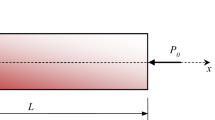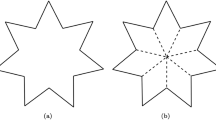Abstract
In this paper, the stress fields in nonlinear sandwich and laminated composite shells subjected to displacement-dependent loads are analyzed. To solve the problem, the geometrically exact (GeX) hybrid-mixed four-node solid-shell element is proposed. The term GeX means that the middle surface is described by analytical functions, i.e., the parametrization of the surface is known. The laminated solid-shell element formulation is based on the choice of an arbitrary number of sampling surfaces (SaS) parallel to the middle surface and located at the Chebyshev polynomial nodes within the layers, in order to introduce the displacements of these surfaces as unknown functions. The outer surfaces and interfaces are also included into a set of SaS. Due to analytical integration utilized to evaluate the tangent stiffness matrix, the developed GeX solid-shell element under non-conservative loading shows excellent performance in the case of coarse meshes and makes it possible to use only one load step in most of the considered benchmark problems. It is shown that the difference between the second Piola–Kirchhoff and Cauchy stress tensors in some non-conservative problems for sandwich and laminated shells undergoing arbitrarily large rotations can be significant.



















Similar content being viewed by others

References
Patel, H.P., Kennedy, R.H.: Nonlinear finite element analysis for composite structures of axisymmetric geometry and loading. Comput. Struct. 15, 79–84 (1982)
Trinko, M.J.: Ply and rubber stresses and contact forces for a loaded radial tire. Tire Sci. Technol. 11, 20–38 (1984)
Tielking, J.T.: A finite element tire model. Tire Sci. Technol. 11, 50–63 (1984)
Rothert, H., Gall, R.: On the three-dimensional computation of steel-belted tires. Tire Sci. Technol. 14, 116–124 (1986)
Tseng, N.T.: Finite element analysis of freely rotating tires. Tire Sci. Technol. 15, 134–158 (1987)
Chang, J.P., Satyamurthy, K., Tseng, N.T.: An efficient approach to the three-dimensional finite element analysis of tires. Tire Sci. Technol. 16, 249–273 (1988)
Faria, L.O., Bass, J.M., Oden, J.T., Becker, E.B.: A three-dimensional rolling contact model for a reinforced rubber tire. Tire Sci. Technol. 17, 217–233 (1989)
Domscheit, A., Rothert, H., Winkelmann, T.: Refined methods for tire computation. Tire Sci. Technol. 17, 291–304 (1989)
Faria, L.O., Oden, J.T., Yavary, B., Tworzydlo, W.W., Bass, J.M., Becker, E.B.: Tire modeling by finite elements. Tire Sci. Technol. 20, 33–56 (1992)
Danielson, K.T., Noor, A.K., Green, J.S.: Computational strategies for tire modeling and analysis. Comput. Struct. 61, 673–693 (1996)
Greer, J.M., Palazotto, A.N.: Application of a total Lagrangian corotational finite element scheme to inflation of a tire. Int. J. Solids Struct. 34, 3541–3570 (1997)
Grigolyuk, E.I., Kulikov, G.M.: Axisymmetric deformation of anisotropic multilayered shells of revolution of intricate shapes. Mech. Compos. Mater. 17, 437–445 (1982)
Grigolyuk, E.I., Kulikov, G.M.: Multilayered Reinforced Shells: Analysis of Pneumatic Tires. Mashinostroyenie, Moscow (1988)
Kim, K.O., Tanner, J.A., Noor, A.K., Robinson, M.P.: Computational methods for frictionless contact with application to space shuttle orbiter nose-gear tires. NASA TP-3073. NASA, Washington (1991)
Noor, A.K., Tanner, J.A., Peters, J.M.: Reduced basis technique for evaluating sensitivity derivatives of the nonlinear response of the space shuttle orbiter nose-gear tire. Tire Sci. Technol. 21, 232–259 (1993)
Tanner, J.A., Martinson, V.J., Robinson, M.P.: Static frictional contact of the space shuttle nose-gear tire. Tire Sci. Technol. 22, 242–272 (1994)
Kulikov, G.M.: Computational models for multilayered composite shells with application to tires. Tire Sci. Technol. 24, 1–38 (1996)
Kulikov, G.M., Plotnikova, S.V.: Calculation of composite structures subjected to follower loads by using a geometrically exact shell element. Mech. Compos. Mater. 45, 545–556 (2009)
Kulikov, G.M., Plotnikova, S.V.: Contact interaction of composite shells, subjected to follower loads, with a rigid convex foundation. Mech. Compos. Mater. 46, 43–56 (2010)
Pagani, A., Azzara, R., Wu, B., Carrera, E.: Effect of different geometrically nonlinear strain measures on the static nonlinear response of isotropic and composite shells with constant curvature. Int. J. Mech. Sci. 209, 106713 (2021)
Pagani, A., Azzara, R., Carrera, E.: Geometrically nonlinear analysis and vibration of in-plane-loaded variable angle tow composite plates and shells. Acta Mech. 234, 85–108 (2023)
Kulikov, G.M., Plotnikova, S.V.: Finite rotation exact geometry solid-shell element for laminated composite structures through extended SaS formulation and 3D analytical integration. Int. J. Numer. Methods Eng. 119, 852–878 (2019)
Kulikov, G.M., Plotnikova, S.V.: Exact geometry SaS-based solid–shell element for coupled thermoelectroelastic analysis of smart structures with temperature-dependent material properties. Acta Mech. 234, 163–189 (2023)
Kulikov, G.M., Plotnikova, S.V.: Advanced formulation for laminated composite shells: 3D stress analysis and rigid-body motions. Compos. Struct. 95, 236–246 (2013)
Pian, T.H.H.: State-of-the-art development of hybrid/mixed finite element method. Finite Elem. Anal. Design 21, 5–20 (1995)
Sze, K.Y., Chan, W.K., Pian, T.H.H.: An eight-node hybrid-stress solid-shell element for geometric non-linear analysis of elastic shells. Int. J. Numer. Methods Eng. 55, 853–878 (2002)
Sansour, C., Kollmann, F.G.: Families of 4-node and 9-node finite elements for a finite deformation shell theory. An assessment of hybrid stress, hybrid strain and enhanced strain elements. Comput. Mech. 24, 435–447 (2000)
Kulikov, G.M., Bohlooly, M., Plotnikova, S.V., Kouchakzadeh, M.A., Glebov, A.O.: Nonlinear displacement-based and hybrid-mixed quadrilaterals for three-dimensional stress analysis through sampling surfaces formulation. Thin-Walled Struct. 155, 106918 (2020)
Yeom, C.H., Lee, S.W.: An assumed strain finite element model for large deflection composite shells. Int. J. Numer. Methods Eng. 28, 1749–1768 (1989)
Park, H.C., Cho, C., Lee, S.W.: An efficient assumed strain element model with six dof per node for geometrically nonlinear shells. Int. J. Numer. Methods Eng. 38, 4101–4122 (1995)
Kulikov, G.M., Plotnikova, S.V.: Non-linear strain-displacement equations exactly representing large rigid-body motions. Part I. Timoshenko-Mindlin shell theory. Comput. Methods Appl. Mech. Eng. 192, 851–875 (2003)
Klinkel, S., Gruttmann, F., Wagner, W.: A robust non-linear solid shell element based on a mixed variational formulation. Comput. Methods Appl. Mech. Eng. 195, 179–201 (2006)
Pian, T.H.H., Sumihara, K.: Rational approach for assumed stress finite elements. Int. J. Numer. Methods Eng. 20, 685–1695 (1984)
Lee, S.W., Pian, T.H.H.: Improvement of plate and shell finite elements by mixed formulations. AIAA J. 16, 9–34 (1978)
Wempner, G., Talaslidis, D., Hwang, C.M.: A simple and efficient approximation of shells via finite quadrilateral elements. J. Appl. Mech. 49, 115–120 (1982)
Kulikov, G.M., Plotnikova, S.V.: On the second Piola-Kirchhoff and Cauchy stress tensors in nonlinear shells subjected to displacement-dependent loads. Mech. Adv. Mater. Struct. (2023). https://doi.org/10.1080/15376494.2023.2180121
Kulikov, G.M., Mamontov, A.A., Plotnikova, S.V., Mamontov, S.A.: Exact geometry solid-shell element based on a sampling surfaces technique for 3D stress analysis of doubly-curved composite shells. Curved Layered Struct. 3, 1–16 (2016)
Braun, M., Bischoff, M., Ramm, E.: Nonlinear shell formulations for complete three-dimensional constitutive laws including composites and laminates. Comp. Mech. 15, 1–18 (1994)
Vu-Quoc, L., Tan, X.G.: Optimal solid shells for non-linear analyses of multilayer composites. I Statics. Comput. Methods Appl. Mech. Eng. 192, 975–1016 (2003)
Parisch, H.: A continuum-based shell theory for non-linear applications. Int. J. Numer. Methods Eng. 38, 1855–1883 (1995)
Basar, Y., Itskov, M., Eckstein, A.: Composite laminates: nonlinear interlaminar stress analysis by multi-layer shell elements. Comput. Methods Appl. Mech. Eng. 185, 367–397 (2000)
El-Abbasi, N., Meguid, S.A.: A new shell element accounting for through-thickness deformation. Comput. Methods Appl. Mech. Eng. 189, 41–862 (2000)
Brank, B.: Nonlinear shell models with seven kinematic parameters. Comput. Methods Appl. Mech. Eng. 194, 336–2362 (2005)
Kulikov, G.M., Plotnikova, S.V.: Hybrid-mixed ANS finite elements for stress analysis of laminated composite structures: Sampling surfaces plate formulation. Comput. Methods Appl. Mech. Eng. 303, 374–399 (2016)
Kulikov, G.M., Plotnikova, S.V.: Exact geometry four-node solid-shell element for stress analysis of functionally graded shell structures via advanced SaS formulation. Mech. Adv. Mater. Struct. 27, 948–964 (2020)
Argyris, J.H., Symeonidis, S.: Nonlinear finite element analysis of elastic systems under nonconservative loading—natural formulation. Part I. Quasistatic problems. Comput. Methods Appl. Mech. Eng. 26, 75–123 (1981)
Schweizerhof, K., Ramm, E.: Displacement dependent pressure loads in nonlinear finite element analyses. Comp. Struct. 18, 1099–1114 (1984)
Boland, P.L., Pian, T.H.H.: Large deflection analysis of thin elastic structures by the assumed stress hybrid finite element method. Comp. Struct. 7, 1–12 (1977)
Cho, C., Lee, S.W.: On the assumed strain formulation for geometrically nonlinear analysis. Finite Elem. Anal. Design 24, 31–47 (1996)
Kulikov, G.M., Plotnikova, S.V.: Non-linear strain-displacement equations exactly representing large rigid-body motions. Part II. Enhanced finite element technique. Comput. Methods Appl. Mech. Eng. 195, 2209–2230 (2006)
Washizu, K.: Variational Methods in Elasticity and Plasticity, 3rd edn. Pergamon Press, Oxford (1982)
Seide, P., Jamjoom, T.M.M.: Large deformations of circular rings under nonuniform normal pressure. J. Appl. Mech. 41, 192–196 (1974)
Fafard, M., Dhatt, G., Batoz, J.L.: A new discrete Kirchhoff plate/shell element with updated procedures. Comput. Struct. 31, 591–606 (1989)
Mohan, P., Kapania, R.K.: Updated Lagrangian formulation of a flat triangular element for thin laminated shells. AIAA J. 36, 273–281 (1998)
Bohlooly, M., Kulikov, G.M., Plotnikova, S.V., Kouchakzadeh, M.A.: Three-dimensional stress analysis of structures in instability conditions using nonlinear displacement-based and hybrid-mixed quadrilaterals based on SaS formulation. Int. J. Non-Linear Mech. 126, 103540 (2020)
Funding
This work was supported by the Russian Science Foundation under Grant No. 24-21-00120.
Author information
Authors and Affiliations
Corresponding author
Ethics declarations
Conflict of interest
The authors declare that they have no conflict of interest.
Additional information
Publisher's Note
Springer Nature remains neutral with regard to jurisdictional claims in published maps and institutional affiliations.
Appendix A
Appendix A
The element stiffness matrix \({\mathbf{K}}_{{\text{F}}}\) of order \(12N_{{{\text{SaS}}}} \times 12N_{{{\text{SaS}}}}\), introduced in Sect. 6 to take into account non-conservative loading, can be written in a closed form. The use of Eqs. (39), (40), (48), (53) and (55) leads to the following matrix:
whose columns with nonzero elements are
where
where \(A_{\alpha r}\) and \(\overline{A}_{\alpha }\) are the coefficients of the first fundamental form at the nodes and the center of the element, and, as we remember, the nodal indices \(r,\,s = 1,\,2,\,3,\,4\).
Rights and permissions
Springer Nature or its licensor (e.g. a society or other partner) holds exclusive rights to this article under a publishing agreement with the author(s) or other rightsholder(s); author self-archiving of the accepted manuscript version of this article is solely governed by the terms of such publishing agreement and applicable law.
About this article
Cite this article
Kulikov, G.M., Plotnikova, S.V. & Mamontov, A.A. Assessment of second Piola–Kirchhoff and Cauchy stress tensors in finite rotation sandwich and laminated shells under non-conservative pressure loads. Acta Mech (2024). https://doi.org/10.1007/s00707-024-03925-y
Received:
Revised:
Accepted:
Published:
DOI: https://doi.org/10.1007/s00707-024-03925-y



